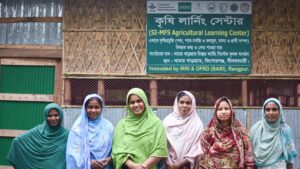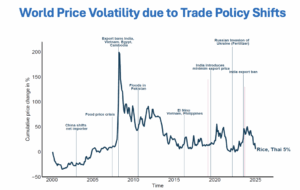by K. Saito, K. Senthilkumar, E. R. Dossou-Yovo, I. Ali, J-M. Johnson, G. Mujawamariya, and J. Rodenburg
Significant efforts in agronomic research for development have been undertaken to address the challenges in rice cultivation in sub-Saharan Africa. Despite these efforts and achievements, considerable yield gaps in researcher-managed trials as well as farmers’ fields persist. The objectives of this paper are to provide the status quo of rice production and its main challenges, selected achievements in rice agronomy research mainly by Africa Rice Center, and its partners, and perspectives for future research on rice agronomy.
Rice is one of the most important staple crops for food security and social stability in large parts of sub-Saharan Africa (SSA). Its consumption has been increasing more rapidly than any other staple crop (Arouna et al., 2021). This rapid increase is driven by high population growth, urbanization, and changing consumer preferences in the region.
Recently reaching one billion inhabitants, SSA has had the highest population growth rate in the world with a mean increase of 2.5% per annum between 2007 and 2016. During the same period, rice consumption has increased, at a rate of 6% per annum, and is expected to continue to grow in the foreseeable future.
In response to its growing demand in SSA, rice production has increased tenfold since 1961. This has resulted mostly from both an expansion of rice harvested area and, albeit to a lesser extent, an increase in rice production per unit of land (referring to as yield).
Between 2000 and 2020, the harvested area increased from 6.9 million ha to 16.6 million ha, whereas the gain in rice yield was limited, only increasing from 1.7 to 2.1 t/ha. Recent yield levels are still much lower than the global average which is around 4.8 t /ha.
Furthermore, on average in SSA countries, actual yields are less than half of the potential yield (Yp) or water-limited yield (Yw), suggesting that doubling rice yield is possible. ‘Yp’ is defined as the maximum yield that can be obtained from a crop in a given environment, as determined by simulation models with plausible physiological and agronomic assumptions.
Under irrigated conditions, potential yield is determined by climate (solar radiation and temperature), varietal characteristics, and crop establishment methods including sowing date and density. Under rainfed environments, ‘Yw’ is affected by water availability.
In 2020, rice consumption in SSA was estimated to be 32.2 million tons of milled rice, which was partially fulfilled by the importation of approximately 15.6 million tons (equivalent to 33% of the world market), indicating that the self-sufficiency rate in SSA is only 48%.
The large gap between demand and supply for rice has pointed to the attention of African governments and international donors to efforts to strengthen the rice sector to achieve self-sufficiency in SSA.
The objectives of this paper are to provide the status quo of (i) rice production and its main challenges, (ii) selected achievements in rice agronomy research mainly by Africa Rice Center (AfricaRice) and its partners, and (iii) perspectives for future research on rice agronomy in SSA.
This paper does not intend to summarize their reviews, but to provide complementary information, which were missing in those reviews, and present perspectives for future research, building on these publications. Thus, the main foci in this paper are (i) climate risks and associated crop management practices in rainfed environments, (ii) soil-related constraints, and (iii) labor issues in rice cultivation.
First, we summarize the characteristics of rice-growing environments and farmers’ rice cultivation practices, and some of the sustainable rice performance indicators such as yield and profit of three rice-growing environments based on recent studies. Second, we discuss climate risks, soil-related constraints, and labor issues in rice cultivation. Then, we showcase some of the key technologies developed by Africa Rice Center and partners, addressing various challenges, and we discuss perspectives for future research
This review shows that significant efforts in agronomic research for development have been undertaken to address the challenges in rice cultivation in SSA. Despite these efforts and achievements, however, considerable yield gaps in researcher-managed trials as well as farmers’ fields persist. Further improving rice yield and closing the rice yield gaps across environments, is an essential objective for achieving food security and rice self-sufficiency.
Sustainable intensification in rainfed lowlands and uplands offers substantial room for increasing rice production because total rainfed rice represents > 70% of the total rice harvested area in SSA. Agronomists and crop scientists should demonstrate how much the yield gap could realistically be closed with integrated crop management practices.
Collaboration needs to be strengthened among scientists from different disciplines. Breeders, soil scientists, crop modelers, remote sensing and GIS specialists, mechanization specialists, social scientists, and agronomists/crop scientists would play important roles in these priority areas.
We believe that such collaborative efforts will deliver locally adapted agronomic solutions for sustainable intensification, especially in rainfed rice to enhance the resilience to climate change and increase land and labor
productivity and sustainability of rice cultivation in SSA.
In addition to such research efforts, enabling environments are essential for success in SSA, such as farmers’ (particularly women’s) access to agro-input and machinery, training, extension systems, markets, and financial services.
Engagement with public and private stakeholders is also needed to enhance farmers’ adoption of agronomic solutions.
Read the study:
Saito K. Senthilkumar K, Dossou-Yovo ER, Ali, Johnson JM, Mujawamariya G. and Rodenburg J. 2023. Status quo and challenges of rice production in sub-Saharan Africa. Plant Production Science, 26:3, 320-333.






